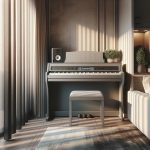Stepping into the world of live gigs can be thrilling for any budding musician. It's that electrifying moment when you're ready to share your music with the world. But before you hit the stage, there's one crucial choice to make: finding the right beginner keyboard that won't let you down under the spotlight.
Choosing a keyboard for live performances is a bit like picking a partner for a dance. It needs to match your rhythm, amplify your sound, and most importantly, keep up with the pace of your musical journey. Whether you're playing cozy café gigs or dreaming of larger venues, the perfect keyboard can make all the difference in how your music is received.
Understanding the Basics of Live Gig Keyboards
When embarking on the journey of live performances, understanding the basics of live gig keyboards is a crucial step for beginners. A keyboard isn't just an instrument; it's a musical companion that contributes to the texture and depth of your performance. Different keyboards have diverse functionality, quality, and capabilities which directly influence your sound and adaptability on stage.
Key Components to Consider
Before diving into the vast pool of options, there are essential components every budding musician should consider:
- Weighted Keys: They mimic the resistance and feel of an acoustic piano, offering a dynamic range that can enhance expression in your performance.
- Polyphony: This refers to the number of notes a keyboard can produce simultaneously. Higher polyphony allows for more complex and richer sounds.
- Built-In Sounds: A variety of built-in tones and effects can inspire creativity and add flavor to your music.
- Connectivity: Features like USB and MIDI connections are vital for recording and integrating other digital gear into your performances.
Keyboards Versus Digital Pianos
It's common for beginners to confuse keyboards with digital pianos. While they look similar, each serves a different purpose, especially in live gigs. Digital pianos focus on emulating the sound and feel of an acoustic piano, often with weighted keys and limited sound customization. Keyboards, however, offer a broader range of sounds and effects, are more portable, and typically have features more aligned with live performance needs such as looping and layering sounds.
Budget Considerations
Budget inevitably plays a significant role in the decision-making process. Investing in a high-quality keyboard from the start can be more economical in the long run, as it might prevent the need for an upgrade too soon. However, there are affordable options that do not compromise on the essential features necessary for live performances. It's about finding the right balance between cost and functionality to ensure you get the best value for your money.
| Feature | Essential | Nice-to-Have |
|---|---|---|
| Weighted Keys | Yes | Depending on preference |
| High Polyphony | Yes | For complex pieces |
| Built-In Sounds | Yes | For versatility |
| Connectivity | Yes | For expansion |
- Try Before You Buy: Spend time with different keyboards to see what feels right. The connection between musician and instrument is deeply personal.
- **
Key Features to Look for in a Beginner Keyboard

When venturing into the world of live gigs, beginners must know which features are crucial in a keyboard. This knowledge ensures they select an instrument that not only enhances their performance but also stands the test of time as they grow as musicians.
Weighted keys are a top priority. They mimic the resistance and rebound of an acoustic piano, providing a more authentic playing experience. This feature is vital for developing proper finger technique and dynamics in performance. For those starting, the transition to different keyboards or pianos becomes smoother with weighted keys.
Next, polyphony plays a crucial role. Polyphony refers to the number of notes a keyboard can produce at once. For beginners, a 32-note polyphony is often sufficient. However, as skills and musical pieces become more complex, opting for a keyboard with 64 or more notes of polyphony becomes beneficial. This allows for richer, more complex sound without note dropouts, especially during fast passages or when layering sounds.
Built-in sounds offer a palette for creativity and expression. A keyboard with a wide range of quality sounds, including pianos, organs, strings, and synthesizers, invites exploration and allows beginners to experiment with different genres and textures. Some keyboards also offer the ability to layer sounds or split the keyboard into different voices, which can add depth to live performances.
Connectivity is another essential feature. USB MIDI connectivity allows the keyboard to interface with computers and recording software, opening up a world of possibilities for music production and learning. An AUX input for playing along with music from a phone or MP3 player can be beneficial for practice. Some keyboards also offer Bluetooth connectivity, making it easier to use apps and software tools that can aid in learning and performing.
Considering budget is also important. While it’s tempting to opt for the cheapest option, investing in a keyboard with these key features can significantly improve the learning and performing experience. Beginners should balance cost with functionality, aiming for the best they can afford without overspending on advanced features they may not yet need.
Before making a purchase, trying out different keyboards is invaluable. It allows beginners to feel the difference in key action, hear the sound quality firsthand, and explore the ease of use of each model. Personal preference plays a significant role in choosing an instrument, and what works for one beginner may not suit another.
| Feature | Importance |
|---|---|
Top Beginner Keyboards for Live Gigs

When venturing into the world of live performance, the choice of instrument can make all the difference. For those just starting out, finding the perfect beginner keyboard that balances cost, functionality, and portability is key. Here's a look at some top picks that tick all these boxes and are particularly well-suited for live gigs.
Yamaha PSS-A50
The Yamaha PSS-A50 is renowned for its portability and versatility, making it a fantastic choice for beginners. It features 37 mini keys that are touch-sensitive, ensuring that performers can play with expression. Despite its compact size, it doesn't skimp on sound quality. With a wide variety of built-in voices and rhythms, it allows for creative performances anywhere.
- Weight: Light and portable
- Key Feature: Phrase Recorder for looping and layering
Casio CT-S300
Casio's CT-S300 is another excellent beginner keyboard, especially valued for its 61 touch-responsive keys. It stands out for its usability, incorporating a pitch bend wheel and a USB to host connectivity option. This keyboard not only supports a variety of music genres but its built-in carry handle also makes it incredibly easy to transport to gigs.
- Weight: Easily portable
- Key Feature: Dance Music Mode for instant music tracks
Roland GO:KEYS
Roland's GO:KEYS keyboard is designed with creativity in mind. It features 61 keys and offers a unique loop mix function, allowing beginners to build fully produced songs without any previous music production experience. Bluetooth connectivity enables streaming and playing along with your favorite songs, adding an interactive aspect to practice and performance.
- Weight: Moderately light
- Key Feature: Bluetooth MIDI and audio support
Korg B2
The Korg B2 is a brilliant choice for beginners who are serious about their piano playing journey. With 88 Natural Weighted Hammer Action keys, it provides an authentic acoustic piano feel. It comes equipped with a variety of high-quality sounds, from grand pianos to electronic organs, and features USB MIDI/Audio, enabling direct connection to music production software.
- Weight: Heavier, suited for stationary setups
- Key Feature: Versatile sound library
Tips for Optimizing Your Keyboard Performance On Stage

When it comes to live performances, having a great keyboard is only part of the equation. Optimizing your keyboard for the stage is crucial for ensuring a stellar performance. Here are some tips to help you make the most out of your live gigs.
Understand Your Gear Inside and Out
Before hitting the stage, it's essential that you're familiar with every aspect of your keyboard. Spend time exploring its features, experimenting with sounds, and understanding its limits. This knowledge will allow you to troubleshoot on the fly and make quick adjustments as needed, ensuring your performance runs smoothly.
- Explore all Features: Dive deep into your keyboard’s capabilities.
- Practice Frequently: Regular practice sessions help you master your instrument.
Customize Your Sound
Creating a unique sound can help you stand out during live performances. Most beginner keyboards offer a range of presets and effects that can be customized. Experiment with these options in advance to find a combination that best suits your style and the genre of music you're performing.
- Experiment with Presets: Use built-in sounds to learn what works for you.
- Adjust Effects: Reverb, chorus, and delay can add depth to your sound.
Optimize Your Setup
A well-thought-out setup is key for a smooth performance. Position your keyboard so it's comfortable for playing and easy to reach all the controls. If you're using multiple keyboards or modules, ensure they are easily accessible. Also, consider the height of your keyboard stand for optimal posture and performance comfort.
- Ergonomic Positioning: Adjust the keyboard height for comfort.
- Accessible Controls: Make sure all necessary controls are within easy reach.
Sound Check Is a Must
Never underestimate the importance of a good sound check. This is the perfect opportunity to adjust your levels and ensure your keyboard blends well with the rest of the band and the venue's sound system. A proper sound check can prevent feedback issues and ensure your keyboard is heard clearly across the venue.
- Adjust Levels: Balance your keyboard volume with the band and venue.
- Check for Feedback: Identify and resolve any potential feedback problems.
Engage with Your Audience
Engagement is key to an unforgettable performance. Your interaction with the audience can make a significant difference. Make eye contact, smile, and move with the music. Your body language can communicate your enthusiasm and passion for the music, inviting the audience into your performance.
- **Make
Must-Have Accessories for Your Live Gig Keyboard Setup

When it comes to performing live, having the right keyboard is just the beginning. To truly elevate your performance and ensure everything runs smoothly, there are several must-have accessories that should accompany your keyboard setup. These items not only enhance the playing experience but also help in managing your gear efficiently on stage.
Quality Keyboard Stand
A sturdy keyboard stand is non-negotiable. It's essential for keeping your instrument secure and at the right height, which can significantly affect your comfort and playing posture. Look for stands that offer adjustability and stability, especially if you're performing on uneven surfaces. Some popular options include X-stands for their portability and Z-stands for their exceptional stability and space for additional gear.
Sustain Pedal
The sustain pedal is a necessary extension of your expressiveness on the keyboard. It allows notes to ring out longer, providing that essential connection between your touch and the overall sound. Opt for a pedal that mimics the feel and response of an acoustic piano pedal, ensuring a natural and intuitive playing experience.
Keyboard Case or Gig Bag
Protecting your instrument during transport is crucial. A high-quality keyboard case or gig bag with padding can safeguard your keyboard from bumps, scratches, and the elements. Hard cases offer the best protection, while soft gig bags are lighter and usually have pockets for storing cables and other accessories.
Sound System
Depending on the venue, you might need to bring your own sound system or monitor. A good portable PA system can make a huge difference in how your music is heard, both by you and the audience. Additionally, having a personal monitor on stage can help you stay in tune with your performance without relying solely on the venue's sound system.
Cables and Power Strips
Never underestimate the necessity of having extra cables and a reliable power strip with surge protection. Having backups is crucial, as cables can fail unexpectedly. A power strip ensures you can plug in all your gear, even when power outlets are scarce or inconveniently positioned.
Setlist Stand
A setlist stand or music sheet holder can be incredibly helpful, especially for beginners or those playing intricate pieces. Being able to glance at your setlist or scores without disrupting your performance can keep things flowing smoothly.
Conclusion
Choosing the right beginner keyboard for live gigs is just the start. It's about making that keyboard work for you in the best way possible. Remember, the magic doesn't just lie in the instrument but also in how you use it. By thoroughly understanding your gear, customizing your sound to fit the venue, and ensuring your setup is as comfortable and accessible as possible, you're setting the stage for success. Don't forget the importance of a good sound check and the role of engaging with your audience. These elements combined will help create an unforgettable live performance. And with the right accessories in your arsenal, you're not just prepared, but also protected and ready to deliver a smooth show. So go ahead, take these tips, and make your mark on the stage. Your journey to captivating live performances starts here.
Harlan Kilstein began playing piano during covid with no piano background at all. He taught himself how to play learning what to do and what not to do.
Today he's an advanced intermediate player and can help you grow in your skills because he learned all this on his own.






